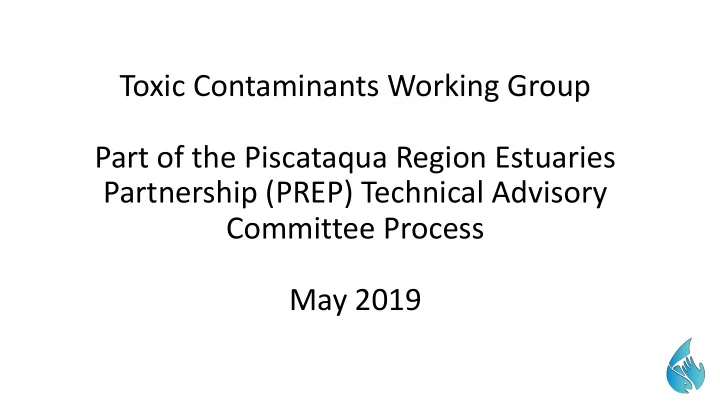

Toxic Contaminants Working Group Part of the Piscataqua Region Estuaries Partnership (PREP) Technical Advisory Committee Process May 2019
PREP’s Objectives https://scholars.unh.edu/prep/22/
PREP’s Objectives
PREP’s Objectives…and Action Plans
A Brief History of Time and Toxics https://www.stateofourestuaries.org/2018-reports/
Monitoring Plan Indicators Indicator and Question Status None of these indicators really (TOX1) Shellfish Tissue Concentrations Relative to FDA Standards. Are Discontinued in 2009 get at “loading,” which was one shellfish, lobsters, finfish, and other seafood species from NH coastal of the primary objectives waters fit for human consumption? (TOX3)Trends in Shellfish Tissue Contaminant Concentrations. Have the Funding stopped in 2015…hoping to begin again this concentrations of toxic contaminants in estuarine biota changed over year. time? (TOX5) Sediment Contaminant Concentrations Relative to NOAA Discontinued in 2009 Guidelines. Do NH tidal sediments contain heavy metals, PCBs, PAHs, chlorinated pesticides, and other toxic contaminants that are harmful to humans, animals, plant, and other aquatic life? (TOX6) Trends in Sediment Contaminant Concentrations. Have the Discontinued in 2009 concentrations of toxic contaminants in sediment significantly changed over time? (TOX7) Benthic Community Impacts Due to Sediment Contamination. Is Discontinued in 2009 there evidence of toxic effects of contaminants in estuarine biota? (TOX8) Finfish and Lobster Edible Tissue Concentrations Relative to Risk Discontinued between 2008 and 2012 Based Standards. Are shellfish, lobsters, finfish, and other seafood species from NH coastal waters fit for human consumption?
TOX1: Shellfish Tissue Concentrations Relative to FDA Standards
TOX3: Trends in Shellfish Tissue Contaminant Concentrations
TOX3: Trends in Shellfish Tissue Contaminant Concentrations (cont’d)
TOX5: Sediment Contaminant Concentrations Relative to NOAA Guidelines “The chemicals that have concentrations greater than PECs or five times TECs are: chromium, copper, mercury, lead, PAHs, PCBs, DDT (and its metabolites), lindane, and dieldrin. Of these compounds, PAHs are the most common contaminant.”
TOX5: Sediment Contaminant Concentrations Relative to NOAA Guidelines
TOX6: Trends in Sediment Contaminant Concentrations May be limited to PCBs, DDTs and PAHs.
TOX7: Benthic Community Impacts Due to Sediment Contamination “Sediment impairments will be determined using a combination of sediment chemistry, sediment toxicity and benthic community data. Sediment chemistry data will be evaluated using screening values from the DES Sediment Policy Sediment toxicity will be assessed using the test organism Ampelisca abdita . Benthic community data will be evaluated using a benthic index for Gulf of Maine sediments developed by the Atlantic Ecology Division of EPA”
TOX8: Finfish/Lobster Edible Tissue Conc. Relative to Risk Based Standards
What’s Happening Now? - What is currently going on relevant to the topic? - What are near-future opportunities that should be discussed? - How should we discuss pricing different options for moving forward with GulfWatch at various levels: (e.g., previous, previous+expanded to CEC’s...which CECs, etc.)
Proposed Changes to PREP CCMP Action Plan WR-21 Activities under WR-21 - Research monitoring techniques - ID risk-based standards - Develop indicators for WWTFs and river monitoring - Track concentrations - What about loading?
Next Steps?
Recommend
More recommend